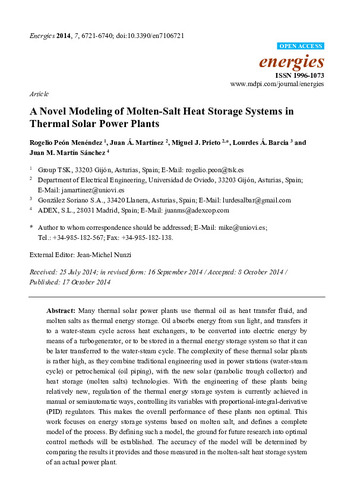A novel modeling of molten-salt heat storage systems in thermal solar power plants
Palabra(s) clave:
Solar thermal power plant
Process modeling
Fecha de publicación:
Editorial:
MDPI
Versión del editor:
Citación:
Descripción física:
Resumen:
Many thermal solar power plants use thermal oil as heat transfer fluid, and molten salts as thermal energy storage. Oil absorbs energy from sun light, and transfers it to a water-steam cycle across heat exchangers, to be converted into electric energy by means of a turbogenerator, or to be stored in a thermal energy storage system so that it can be later transferred to the water-steam cycle. The complexity of these thermal solar plants is rather high, as they combine traditional engineering used in power stations (water-steam cycle) or petrochemical (oil piping), with the new solar (parabolic trough collector) and heat storage (molten salts) technologies. With the engineering of these plants being relatively new, regulation of the thermal energy storage system is currently achieved in manual or semiautomatic ways, controlling its variables with proportional-integral-derivative (PID) regulators. This makes the overall performance of these plants non optimal. This work focuses on energy storage systems based on molten salt, and defines a complete model of the process. By defining such a model, the ground for future research into optimal control methods will be established. The accuracy of the model will be determined by comparing the results it provides and those measured in the molten-salt heat storage system of an actual power plant.
Many thermal solar power plants use thermal oil as heat transfer fluid, and molten salts as thermal energy storage. Oil absorbs energy from sun light, and transfers it to a water-steam cycle across heat exchangers, to be converted into electric energy by means of a turbogenerator, or to be stored in a thermal energy storage system so that it can be later transferred to the water-steam cycle. The complexity of these thermal solar plants is rather high, as they combine traditional engineering used in power stations (water-steam cycle) or petrochemical (oil piping), with the new solar (parabolic trough collector) and heat storage (molten salts) technologies. With the engineering of these plants being relatively new, regulation of the thermal energy storage system is currently achieved in manual or semiautomatic ways, controlling its variables with proportional-integral-derivative (PID) regulators. This makes the overall performance of these plants non optimal. This work focuses on energy storage systems based on molten salt, and defines a complete model of the process. By defining such a model, the ground for future research into optimal control methods will be established. The accuracy of the model will be determined by comparing the results it provides and those measured in the molten-salt heat storage system of an actual power plant.
ISSN:
DOI:
Colecciones
Ficheros en el ítem





